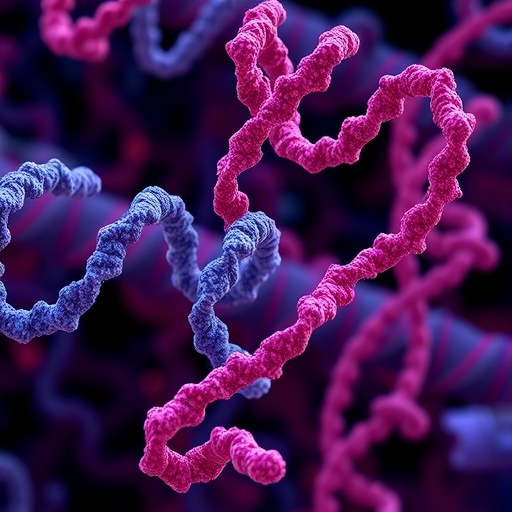In a groundbreaking study published in Nature Communications, researchers have unveiled a critical molecular mechanism that maintains insulin signaling and glucose balance in the body, spotlighting the role of a specific heat shock protein, DNAJA2. This discovery not only deepens our understanding of cellular glucose regulation but also opens new avenues for therapeutic intervention in diabetes and metabolic disorders.
Insulin signaling is fundamental for regulating blood glucose levels, an essential process for energy homeostasis in mammals. At the heart of this regulation lies the insulin receptor (INSR), a transmembrane protein that initiates signaling pathways upon binding insulin. The proper function and localization of INSR on the cell surface are indispensable for effective glucose uptake and metabolism. Disruptions in this process are known contributors to insulin resistance and type 2 diabetes development. However, the cellular mechanisms that preserve the insulin receptor’s presence on the plasma membrane have remained elusive until now.
The team led by Qin et al. has identified the heat shock protein DNAJA2 as a key guardian of insulin receptor stability on the cell surface. Heat shock proteins are traditionally recognized for their roles in protein folding and stress responses, but this research highlights a non-canonical function of DNAJA2 in metabolic regulation. By preventing spontaneous endocytosis—the internalization of the insulin receptor without stimulus—DNAJA2 ensures that INSR remains available on the cell membrane, ready to engage with circulating insulin.
This spontaneous endocytosis, if unchecked, would reduce the number of insulin receptors available for hormone binding, dampening downstream signaling pathways critical for glucose homeostasis. The study demonstrates that DNAJA2 physically interacts with the insulin receptor, stabilizing it and preventing its routine internalization independent of insulin presence. This novel role is vital because maintaining high levels of functional insulin receptors on the plasma membrane directly influences cellular responsiveness to insulin.
Using a combination of cell biology, biochemical assays, and in vivo mouse models, the researchers meticulously detailed the molecular interplay between DNAJA2 and the insulin receptor. Cells deficient in DNAJA2 exhibited a significant increase in spontaneous insulin receptor endocytosis, causing a drastic reduction in receptor availability and impaired insulin signaling. This impairment translated into altered glucose uptake capacity and heightened susceptibility to insulin resistance under metabolic stress.
Interestingly, the study reveals that DNAJA2’s chaperone activity extends beyond classical protein folding to include regulatory control over receptor trafficking. This function is particularly essential in adipocytes and hepatocytes, two predominant insulin-responsive cell types, underscoring the systemic importance of DNAJA2 in maintaining metabolic homeostasis. Through sophisticated imaging and protein interaction analyses, the authors confirmed the specific sequestration of INSR by DNAJA2 at the plasma membrane vicinity, highlighting a previously unrecognized layer of regulation.
Beyond cellular studies, the authors employed genetically engineered mouse models lacking DNAJA2 to examine systemic consequences. These mice showed impaired glucose tolerance and insulin sensitivity, phenotypes characteristic of early-stage diabetes. The findings suggest that DNAJA2 deficiency could potentiate the development of metabolic syndrome by permitting premature and unregulated receptor internalization, thereby weakening the insulin signaling cascade.
This research could revolutionize how we approach insulin resistance therapeutics. Traditional strategies have largely focused on enhancing insulin sensitivity or insulin secretion. However, targeting the molecular machinery that controls receptor availability on the membrane represents an unexplored yet promising direction. Modulating DNAJA2 activity or mimicking its stabilizing effect on INSR may provide a novel class of drugs aimed at preventing or reversing insulin resistance by preserving receptor function and surface expression.
Furthermore, this discovery prompts a reevaluation of heat shock proteins beyond their canonical roles. DNAJA2’s involvement in receptor trafficking hints at a broader functional spectrum for these chaperones in cellular signaling networks. The implications extend to other receptor systems where spontaneous endocytosis might be a regulatory checkpoint conserved by similar molecular chaperones.
The meticulous biochemical analyses presented also suggest that DNAJA2 prevents receptor ubiquitination, a post-translational modification known to tag proteins for degradation or internalization. This mechanism further supports the notion that DNAJA2 acts as a shield, maintaining insulin receptor longevity and surface residency. Future studies aiming to dissect this protective mechanism at atomic resolution could fuel drug discovery efforts by identifying key interaction domains amenable to pharmacological targeting.
Clinically, these findings may shed light on unexplained cases of insulin resistance where receptor expression is normal, but signaling is aberrant. Dysregulation of DNAJA2 or related chaperone pathways could underlie subtle defects in receptor trafficking unnoticed by conventional diagnostic techniques. This insight advocates for deeper molecular phenotyping in diabetes research, leveraging protein trafficking signatures as potential biomarkers.
Finally, the intersection of metabolic regulation and molecular chaperones expands the frontier of personalized medicine for diabetes. Therapies tailored to restore DNAJA2 function or its interaction dynamics with insulin receptors could complement existing treatments, particularly in patients with forms of diabetes refractory to insulin sensitizers or secretagogues.
This compelling study not only advances scientific knowledge about insulin receptor regulation but also encapsulates the intricate interplay between protein homeostasis and cellular metabolism. DNAJA2 emerges as a pivotal protein safeguarding insulin signaling integrity, a finding that may soon translate into innovative strategies to combat the global diabetes epidemic.
Subject of Research:
Regulatory role of heat shock protein DNAJA2 in insulin receptor trafficking and glucose homeostasis.
Article Title:
Heat shock protein DNAJA2 controls insulin signaling and glucose homeostasis by preventing spontaneous insulin receptor endocytosis.
Article References:
Qin, Y., Wu, W., Lin, K. et al. Heat shock protein DNAJA2 controls insulin signaling and glucose homeostasis by preventing spontaneous insulin receptor endocytosis. Nat Commun 16, 9973 (2025). https://doi.org/10.1038/s41467-025-64948-0
Image Credits:
AI Generated




